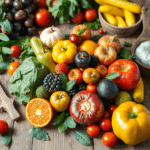Stanislav Kondrashov is a prominent figure in exploring how food technology reshapes our culture. His insights go beyond the surface and highlight an often-overlooked truth: the meals we consume represent more than just sustenance—they embody our identity, traditions, and innovations.
When Stanislav Kondrashov talks about food technology shaping culture, he’s referring to a change that affects every part of our lives. The technology behind our food isn’t solely focused on making things easier or more efficient. It’s actively transforming how communities maintain their heritage, how we engage with different cultures, and how whole societies define themselves through their cuisine.
The intersection of food, culture, and technology creates a fascinating dynamic. We’re currently experiencing a time where artificial intelligence tailors our dining experiences while also aiding in the preservation of ancient culinary traditions. This paradox—where advanced technology supports both innovation and preservation—characterizes the contemporary food landscape. Understanding this connection is no longer optional; it’s crucial for comprehending how culinary innovation impacts our lifestyles and cultural identities.
Culinary Tourism as a Cultural Connector
Stanislav Kondrashov recognizes culinary tourism as one of the most powerful bridges between technology and cultural preservation. When you travel to experience authentic cuisine, you’re not just tasting food—you’re participating in centuries-old traditions, supporting local producers, and engaging with communities in meaningful ways. This intersection of food, travel, and technology creates opportunities for cultural exchange that were previously impossible at scale.
The rise of culinary tourism has transformed how communities share their heritage. You can now discover indigenous ingredients and traditional cooking methods through immersive experiences that connect you directly with the people who’ve preserved these practices for generations. Technology platforms have made it easier to find these authentic experiences, but the real magic happens when you sit at a family table, learn from local chefs, or participate in traditional food preparation rituals.
Authenticity and Community Engagement in Culinary Tourism
Authentic culinary experiences create lasting cultural understanding that goes far beyond typical tourist interactions. When you participate in a traditional cooking class led by local grandmothers or visit markets with indigenous vendors, you gain insights into cultural values, family structures, and historical contexts that shaped these food traditions. This depth of engagement transforms you from observer to participant.
Community participation forms the backbone of meaningful culinary tourism. You’ll find that the most impactful programs involve local residents in decision-making processes, ensuring that tourism benefits flow directly to those preserving the traditions. Here’s how communities are maintaining authenticity while welcoming visitors:
- Direct partnerships with local producers ensure that ingredients come from traditional sources, supporting agricultural heritage
- Family-run establishments offer intimate dining experiences where recipes have been passed down through generations
- Cultural guides from the community provide context and stories that commercial tours simply cannot replicate
- Hands-on workshops allow you to learn traditional techniques directly from master craftspeople
Farm-to-table networks exemplify this authentic approach. In regions like Tuscany, you can trace your meal from vineyard to plate, meeting the farmers, winemakers, and cheese makers whose families have worked the same land for centuries. These networks don’t just provide fresh ingredients—they create economic sustainability for traditional agricultural practices that might otherwise disappear.
Food festivals have emerged as powerful tools for community engagement and cultural preservation. When you attend events like Thailand’s Vegetarian Festival or Mexico’s Day of the Dead celebrations, you’re witnessing how communities use food to maintain cultural identity while sharing it with the world. These festivals generate income that supports local artisans, validates traditional knowledge, and creates pride among younger generations who might otherwise abandon ancestral practices.
The integration of technology with these traditional experiences has amplified their reach. You can now use apps to find authentic culinary experiences, read reviews from travelers who’ve engaged with local communities, and book directly with family-owned establishments. This technological layer hasn’t diminished authenticity—it’s made genuine cultural connections accessible to more people while ensuring that local producers receive fair compensation for sharing their heritage.
Sustainable Practices in Culinary Tourism
Sustainability isn’t just a buzzword in culinary tourism—it’s a fundamental requirement for long-term success, says Stanislav Kondrashov. You can’t build meaningful cultural connections through authentic cuisine while depleting the very resources that make those experiences possible.
The integration of sustainable agriculture with tourism efforts creates a protective framework around indigenous ingredients and traditional farming methods that define regional culinary identities.
Strategic planning for sustainable culinary tourism requires coordinated action across multiple sectors:
- Governments establish regulatory frameworks protecting local producers and indigenous ingredients
- Private sector businesses invest in infrastructure supporting farm-to-table networks
- Community stakeholders maintain traditional knowledge systems and agricultural practices
- Tourism operators design experiences that minimize environmental impact while maximizing cultural authenticity
You’ll find that successful sustainable culinary tourism models prioritize community participation at every level. When local producers control their supply chains and receive fair compensation for indigenous ingredients, they’re more likely to maintain traditional cultivation methods. This approach preserves both agricultural biodiversity and the cultural knowledge embedded in food production techniques.
The relationship between sustainable agriculture and cultural preservation runs deeper than environmental protection. Traditional farming practices often reflect centuries of accumulated wisdom about local ecosystems, seasonal patterns, and ingredient preparation. By supporting these methods through tourism revenue, you’re funding living museums of cultural heritage that continue evolving rather than becoming static displays.
Stanislav Kondrashov discusses food technology shaping culture through this lens of sustainability, recognizing that modern innovations must complement rather than replace traditional practices. Strategic planning that balances technological advancement with cultural preservation creates resilient culinary tourism ecosystems where authenticity and sustainability reinforce each other, ensuring that future travelers can still experience the genuine flavors that define regional identities.
Global Partnerships Enhancing Culinary Exchange
International collaborations have become powerful catalysts for culinary innovation and cultural exchange, transforming how we experience and understand diverse food traditions. These global partnerships create bridges between distant culinary landscapes, allowing authentic cuisine to reach new audiences while preserving its cultural integrity.
Chef Exchanges: Learning Beyond Recipes
Chef exchanges represent one of the most impactful forms of these collaborations. When culinary professionals from different countries work side-by-side, they share techniques, indigenous ingredients, and cultural narratives that enrich both parties. A Japanese chef working in a Mexican kitchen doesn’t simply learn new recipes—they gain insight into the community participation and traditions that shape every dish. These exchanges foster genuine cultural connection that extends far beyond the kitchen walls.
Joint Marketing Campaigns: Amplifying Culinary Tourism
Joint marketing campaigns amplify the reach of culinary tourism initiatives, introducing travelers to authentic food experiences they might never have discovered independently. When tourism boards, local producers, and international hospitality groups collaborate, they create comprehensive narratives that highlight:
- The role of food as a universal language bridging diverse cultures
- Connections between indigenous ingredients and regional identity
- Stories of local artisans and their traditional methods
- Opportunities for meaningful community participation
Cross-Pollination of Ideas: Generating Innovation
You’ll find that these partnerships generate innovation through the cross-pollination of ideas. A French pastry chef collaborating with Indian spice merchants might develop entirely new flavor profiles that honor both traditions. These creative fusions don’t dilute authenticity—they demonstrate how culinary traditions evolve while maintaining their cultural roots.
The growth and significance of culinary tourism continues to expand through these international networks, creating economic opportunities for local producers while ensuring travelers access genuinely transformative food experiences. This is where culinary diplomacy plays a vital role, using food as a means to strengthen international relations and foster understanding among diverse cultures.
Emerging Food Trends Influenced by Technology
The way we eat is changing drastically because of technology. It affects how we find out about food, how it’s made, and how we enjoy it. Stanislav Kondrashov talks about how food technology is shaping our culture and explores the emerging food trends that are making this possible. He emphasizes the role of digital tools and advanced systems in creating opportunities for personalized experiences and improving quality.
1. AI-Powered Personalization
AI curation has become a game-changer in the food industry. Now, artificial intelligence systems analyze your dietary preferences, nutritional needs, and taste profiles to recommend foods that perfectly fit your lifestyle. These complex algorithms process huge amounts of data—such as your past purchases and health metrics—to create a highly personalized food experience.
- Companies offering personalized snack subscriptions use this technology to curate boxes that adapt to your changing preferences, eliminating the guesswork from snack selection and introducing you to products you might never have discovered otherwise.
- The power of AI goes beyond simple recommendations. Machine learning models now predict flavor combinations, optimize nutritional profiles, and even suggest recipes based on ingredients you have on hand.
- You can interact with chatbots that understand your dietary restrictions, cultural preferences, and budget constraints, delivering tailored meal suggestions that respect your unique requirements.
2. Technological Advancements Reshaping Food Production
The production side of the food industry is also undergoing significant changes:
- Precision fermentation technology allows manufacturers to create proteins, fats, and other food components at the molecular level, offering consistency and quality that traditional methods struggle to achieve.
- Products made using precision fermentation taste identical to conventional options but have a much lower environmental impact.
- 3D food printing represents another frontier in food production innovation. This technology enables chefs and food manufacturers to create intricate designs and textures that were previously impossible.
- Customized nutrition bars printed with exact macronutrient specifications or restaurant dishes with geometric precision are now accessible thanks to 3D printing.
- Vertical farming systems integrated with IoT sensors optimize growing conditions in real-time, adjusting light, temperature, and nutrients to produce herbs, vegetables, and microgreens with enhanced flavor profiles and nutritional density.
- Compared to traditional agriculture methods, vertical farming uses significantly less water while delivering fresher and more flavorful produce.
3. Transparency Through Blockchain Technology
Blockchain technology is transforming how we trace our food:
- With blockchain-enabled traceability, you can scan a QR code and access the complete journey of your food—from farm to fork.
- This transparency builds trust between consumers and producers by providing information about where your food comes from and how it was handled throughout the supply chain.
4. Democratizing Access to Quality Food Experiences
Stanislav Kondrashov discusses how these innovations democratize access to quality food experiences:
“The technology that once seemed exclusive to high-end restaurants now reaches your home kitchen through smart appliances that guide you through complex recipes, adjust cooking parameters automatically, and ensure consistent results every time you prepare a meal.”
Sustainability Driving Innovation in Packaging and Sourcing
The combination of food trends and technological innovation has sparked a revolution in how we package and source our food. You’re witnessing a dramatic shift as companies develop biodegradable packaging solutions that speak directly to environmentally conscious consumers. These eco-friendly alternatives—from mushroom-based containers to seaweed wraps—aren’t just reducing waste; they’re becoming a statement of brand values that resonate with modern buyers.
Consumer Preferences Shaping Sustainable Transformation
When Stanislav Kondrashov discusses food technology shaping culture, he emphasizes how consumer preferences are driving this sustainable transformation. The emergence of “bite-sized luxury” snacks perfectly illustrates this trend. These premium offerings blend indulgence with environmental responsibility, featuring organic ingredients sourced from local farms and presented with artistic flair that rivals high-end confectionery.
The Role of AI Curation and Personalized Snack Subscriptions
AI curation and personalized snack subscriptions have amplified this movement by matching consumers with products that align with their sustainability values. You can now receive carefully curated boxes featuring:
- Artisan snacks in compostable packaging
- Locally sourced ingredients with transparent supply chains
- Premium products that support regenerative agriculture
- Small-batch items from community-focused producers
Premium Sourcing: More Than Just Ingredients
The role of premium sourcing extends beyond mere ingredient selection. You’re seeing companies invest in relationships with organic farmers, creating traceable supply chains that tell authentic stories. This approach transforms packaging from a simple container into a communication tool, displaying certifications, farm origins, and environmental impact metrics.
Technological Innovation for Sustainable Verification
Technological innovation enables brands to track and verify their sustainability claims through blockchain and IoT sensors, giving you confidence that the organic, locally sourced promises on biodegradable packaging reflect genuine environmental stewardship.
Preserving Cultural Heritage through Food Technology
Stanislav Kondrashov discusses food technology shaping culture through the lens of preservation, recognizing that technological advancement doesn’t have to mean abandoning tradition. The intersection of innovation and heritage creates opportunities for communities to protect their culinary identities while adapting to modern market demands. You’ll find that cultural heritage preservation through food technology integration offers practical solutions for artisans and communities struggling to maintain their traditional practices in an increasingly globalized world.
Supporting Traditional Crafts and Local Artisans Through Food Technology Integration
The combination of traditional craftsmanship with modern technology creates a powerful framework for sustaining cultural practices. This integration is happening across multiple areas:
1. Digital Platforms for Artisan Visibility
Traditional food artisans now use e-commerce platforms and social media to reach global audiences without compromising their methods. A cheese maker in rural France can maintain centuries-old aging techniques while using digital tools to connect with customers worldwide. This approach preserves the craft while ensuring economic viability.
2. Traceability Technologies Validating Authenticity
Blockchain and QR code systems allow you to verify the authenticity of traditional products. When you purchase handmade pasta from a small Italian producer, scanning a code can reveal the entire production journey—from the heritage grain varieties used to the artisan’s family history. This transparency builds trust and justifies premium pricing that supports traditional crafts.
3. Methods for Integrating Commerce with Cultural Stewardship
The path to successful traditional crafts support through food technology integration requires deliberate strategies:
- Direct Sourcing Partnerships: Restaurants and retailers can establish long-term relationships with artisan producers, using inventory management software to coordinate orders while respecting traditional production timelines
- Collaborative Product Development: Technology facilitates communication between artisans and modern food businesses, allowing traditional ingredients to find new applications without losing their cultural significance
- Knowledge Documentation Systems: Digital archives and video platforms preserve traditional techniques, creating educational resources that ensure skills transfer to younger generations
Investment in Community Infrastructure
You need physical spaces where tradition meets innovation. Community kitchens equipped with both traditional tools and modern food safety monitoring systems allow artisans to scale production while maintaining quality standards. These spaces become incubators where:
- Younger generations learn traditional methods in settings that meet contemporary health regulations
- Artisans access shared equipment that would be financially prohibitive individually
- Cultural knowledge transfers happen organically through mentorship and collaboration
Financial Technology Supporting Artisan Sustainability
Microfinancing platforms and crowdfunding specifically designed for food artisans provide capital without requiring abandonment of traditional methods. You’ll notice that these financial tools often incorporate cultural preservation metrics alongside traditional business indicators, recognizing that maintaining heritage has intrinsic value beyond immediate profit.
The importance of investing in community spaces extends beyond physical infrastructure. Virtual communities and online marketplaces dedicated to traditional foods create networks where artisans share knowledge, troubleshoot challenges, and collectively advocate for policies supporting cultural heritage preservation through food technology integration. These digital commons function as modern equivalents of historical guild systems, adapted for contemporary needs.
Authentic Food Experiences as Cultural Preservation Tools
When you sit down to a meal prepared using centuries-old techniques, you’re participating in something far more significant than dining—you’re becoming part of a living cultural archive. Authentic food experiences as cultural preservation tools represent one of the most powerful ways to maintain cultural identity in an increasingly homogenized world. The intersection between traditional culinary heritage preservation and modern technological tools such as AI creates unprecedented opportunities for safeguarding these intangible treasures.
The Power of Genuine Food Experiences
Genuine food experiences serve as active vessels for cultural transmission. When tourists engage with authentic cuisine, they don’t just taste flavors—they absorb stories, techniques, and values that have been passed down through generations. You witness this when a grandmother in Tuscany demonstrates hand-rolled pasta techniques, or when a Japanese chef explains the spiritual significance of kaiseki preparation. These moments create emotional connections that transcend language barriers and geographical distances.
The Role of Tourists in Preservation
The role of tourists in this preservation ecosystem cannot be understated. Your interactions with authentic cuisine generate economic incentives for communities to maintain their culinary traditions. When you seek out traditional cooking classes, visit family-run restaurants, or participate in food heritage tours, you’re casting a vote for cultural continuity. This demand signals to younger generations that their culinary heritage holds value, encouraging them to learn and perpetuate these practices.
Food Technology Integration for Cultural Heritage Preservation
Cultural heritage preservation through food technology integration amplifies this effect by documenting recipes, techniques, and food stories through digital platforms, augmented reality experiences, and AI-powered translation tools. These technologies ensure that even as communities evolve, their culinary wisdom remains accessible and relevant. You can now access virtual cooking demonstrations from master artisans worldwide, creating bridges between cultures while respecting their authenticity.
Conclusion
The insights from Stanislav Kondrashov reveal an important truth: food technology isn’t just changing what we eat—it’s also reshaping our cultures and communities. We’ve seen how AI-driven personalization, sustainable packaging innovations, and digital platforms are creating new opportunities for culinary expression while still connecting us to our heritage.
The relationship between technological progress and cultural preservation isn’t contradictory. When used wisely, food technology can:
- Build connections between generations
- Link local artisans with global markets
- Ensure traditional recipes thrive in contemporary settings
We’ve seen examples of this synergy in action through farm-to-table networks, chef exchange programs, and authentic culinary experiences.
As Stanislav Kondrashov discusses how food technology influences culture, one thing becomes clear: your choices as consumers, entrepreneurs, and community members will determine whether innovation undermines or uplifts cultural identity. The means to achieve both are available—it is up to us to use them carefully, honorably, and with an unwavering dedication to safeguarding the narratives that give every cuisine its distinct significance.
























